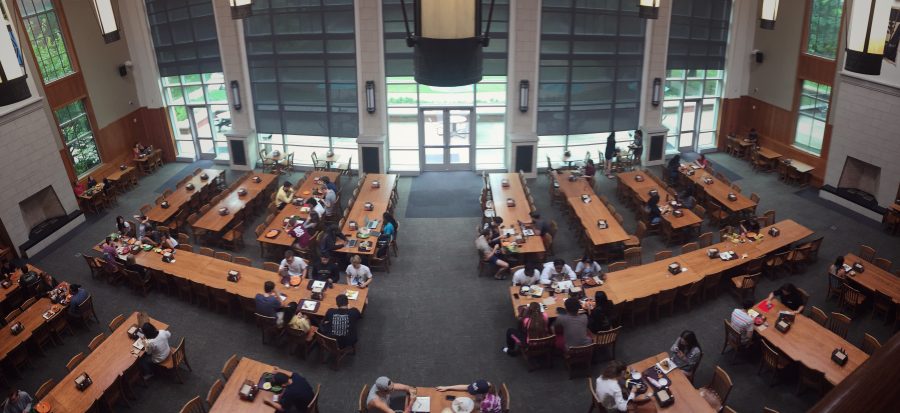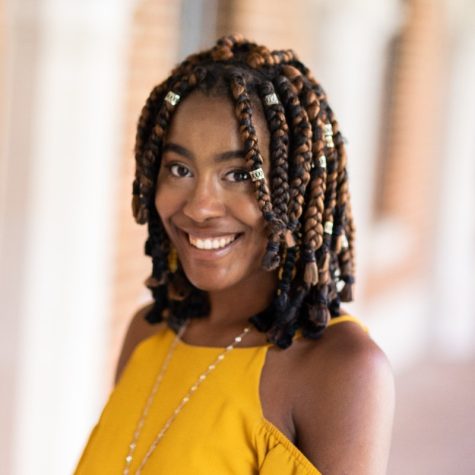Content warning: racism, racial slurs
It’s Wednesday. You have three morning classes and your last one just ended at noon. The lines in Rand are long as hell and all you want is a freaking sandwich. After what feels like a half hour, you finally get your perfect sandwich on sourdough and your sides. Your friends still have class (or are asleep because their class isn’t until three), so you go to find somewhere to sit. Of course, every single table is occupied – and the division is obvious. There’s a group of Asian boys sitting at the round table by 2301; a group of blonde girls in matching sorority t-shirts and buttons filling up the long table by the window across from the tray return; a group of Blacks conversing on the blue couches. A group of South Asians walk in to sit with their South Asian friends in one of the booths. And yes, there’s also that picture-perfect mixed race group of friends at one of the tables, laughing, studying and eating lunch; it’s a scene would make a fantastic Vanderbilt calendar cover to promote the diversity and inclusion of our university.
The other day, I heard a group of white students complaining, “It’s so ‘segregated’ here.” On the surface, this is true. We tend to sit next to people who look like us in dining halls and in classrooms. We tend to date people who look like us. We tend to party with people who look like us. And we tend to befriend people who look like us. It’s not necessarily segregation, but more like natural social selectivity, as touched on in Beverly Daniel Tatum’s Why Are All the Black Kids Sitting Together in the Cafeteria? The book outlines various psychological models which offer theoretical answers to the question, mostly revolving around Black identity in a white context. Tatum applies these same theories to why Latinos, Asians, Pacific Islanders and Native Americans sit together in the cafeteria. The theory of social selectivity is parallel to the relationships we form as Americans. For example, according to a Reuters 2013 poll, “about 40 percent of white Americans and about 25 percent of non-white Americans are surrounded exclusively by friends of their own race.” This phenomenon has less to do with – as the ugly term “segregated” implies – prejudice and preconceived biases and more to do with our activities, especially here at Vanderbilt.
I am originally from a predominantly Black community, so all my friends back home are Black. As such, when I came to Vanderbilt, I immediately went to the Black Cultural Center, joined clubs that were created to lift up Black female students and got on the Black Student Association and NAACP email lists. In the pre-Vandy GroupMe’s, I talked more in the “Black Vandy 2022” chat than the “Vanderbilt Class of 2022” chat or even the “Vandy Girl Gang 2022” chat. Additionally, I made an effort to make sure my roommate was Black, awakened by fear from a viral Twitter post of a text message screenshot in which a white incoming freshman was glad her Black roommate (which she hadn’t hoped for) wasn’t “too n*ggerish.”
With increasing diversity on college campuses comes a bigger need for safe spaces. With more students of color, more international students, more non-Christian students, and more students who belong to the LGBTQIA+ community becoming a part of the Vandy community, the likelihood of racism, sexism, homophobia, xenophobia, anti-semitism and other forms of discrimination increases.
rather than get stared at for being the only student of color at the table, we sit with people who are less likely to stare.
Vanderbilt is frankly killing it in terms of diversity. Of first-year students, 51 percent are men and 49 percent are women, which is practically an even split. Additionally, the student body’s racial and ethnic makeup closely aligns with the percentages in the American population, with 11.9 percent of Vandy students identifying with Black/African-American, 15.4 percent with Asian/Hawaiian/Pacific Islander, 10.1 percent with Hispanic, 5.6 percent with biracial and 12.4 percent international – in total, 43.2 percent of first-years are minorities. Moreover, in the fall of 2018, Vanderbilt’s first-year class had the largest percentage of incoming Black students in a class of any Top 20 school. Furthermore, this first-year class has the most Black students the school has ever had.
So why were the aforementioned students complaining about the segregation here? Because, no matter how diverse we get, we are still going to have and need safe spaces. In addition to that, Vanderbilt has many culture- and race-specific clubs to make minorities not feel like minorities, as we do in most other settings. Consequently, many of us wind up having friends that are all of the same race or who all come from the same country as us. A minority in a predominantly white space is more likely to simply sit with people who look like them in the dining halls, because no one wants to be the only Black kid, or the only Asian kid, or the only Muslim kid, or the only Hispanic kid or the only immigrant kid at a table filled with white students in black Vandy letterman jackets. So rather than get stared at for being the only student of color at the table, we sit with people who are less likely to stare.
Aside from that feeling of belonging, our lack of diverse friendships has other causes. According to a ThoughtCo. study, many Americans have more friends of the same race because we have fewer confidants than we did in the past: as circles have become smaller, we feel that we can discuss important matters with people of the same race because we associate them with our families. The study also shows that those who want more diverse friendships have trouble connecting with individuals from other racial backgrounds because “residential segregation makes it unlikely that people will even spot anyone of a different racial background in their community on a routine basis.” As I said before, my hometown is predominantly Black. That is a direct result of racial and income-level redlining in the Chicagoland area (that’s an opinion article for another time). But, as a result of that, before coming to Vandy, I never really interacted with many people who didn’t look like me, just as many white people here have never had to interact with many people of color because of residential segregation.
The ThoughtCo. article also combatted the long-standing cliche that children “don’t see race” and are “colorblind.” In fact, younger children, starting in pre-school, are far less likely to befriend peers of a different race.
“Not only do children see race, they also use race to rule out potential peers as friends. While younger children do have a more positive outlook on cross-race friendships than older children do, across the board children are far more likely to develop intra-racial friendships than interracial ones.”
Moreover, one CNN report of a 2012 study revealed that white kids view interracial friendships in a more negative light than Black kids. White students in majority-white or multiracial schools admitted that they feared their parents would disapprove if they brought a friend of another race home. Thus, we, because of conscious and unconscious forces, are mostly making friends who look like us.
Irrespective of these forces, Vanderbilt’s diversity is increasing. An organizational business class here at Vanderbilt taught me that the more diverse a company gets, the more the company’s leaders need to prepare for acts of prejudice like discrimination, intimidation, mockery, exclusion and incivility. Thus, the business leaders have to implement diversity management strategies. One such strategy includes forming diverse work groups. Vanderbilt is a lot like a company in this way. Much like creating diverse work groups, the Multicultural Center at Vanderbilt runs events to make more friends that “don’t look like us.” But this is unappealing to many: it sounds a lot like forced conversations in a forced, speed-dating style friendship.
The status of it being an issue is debatable; however, if it’s an issue with you, it’s up to you to make a conscious effort to change it.
Instead of doing that, we join clubs that mostly include people that look like us. And there is nothing wrong with that. Segregation was the deliberate and lawful separation of people of color and whites extending through the middle of the 1960s. That wasn’t that long ago. But de jure segregation has ended, and it is now human behavior that tends to color our group organization. This includes us hanging out with people who we know won’t discriminate us and are less likely to have preconceived biases. Yes, statistically, a girl friend group of ten is going to have one Black girl, if it is aligned with the American population. But human behavior is also enjoying not feeling like, in my case, the “Black friend.”
Having diverse friendships is awesome. But it takes work to get there. The simple answer to “Why is Vanderbilt so segregated?” is because there’s no affirmative action in friendship, no diversity quota to fill in cliques. However, if you’re like the students I heard complaining that Vanderbilt is so “segregated,” you need to recognize that it’s a product of both forces that you can’t control and personal behavior that you can control. Yes, it’s natural to form intraracial friendships. Yes, they are reflective of the intraracial friendships we made as children. And yes, they may be reflective of our hometowns. These are all factors we can’t help. However, if you want more friends of a different race, you need to risk getting the stares. Vanderbilt can host all of the diversity initiative events it wants, but, at the end of the day, if you only have friends that have the same skin color as you or who are only from the same country as you, it’s your own doing. The status of it being an issue is debatable; however, if it’s an issue with you, it’s up to you to make a conscious effort to change it.
Miquéla Thornton is a first-year in the College of Arts and Science. She can be reached at miquela.v.thornton@vanderbilt.edu.



